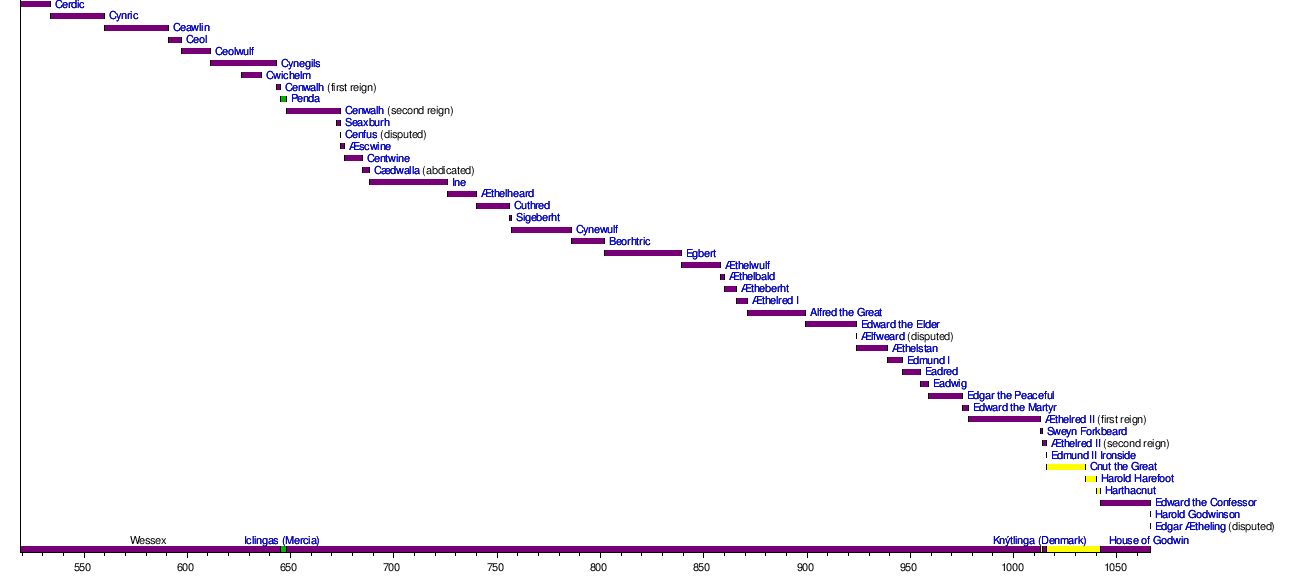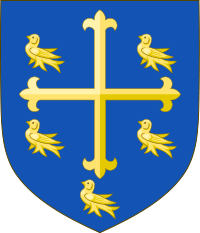House of Wessex
| House of Wessex House of the Gewisse Cerdicings West Saxon dynasty House of the West Saxons | |
|---|---|
| Country | |
| Dissolution | c. 1125 |
| Deposition | 1066 |
| Cadet branches | The Ecgbertings and the Æthelwoldings. |
The House of Wessex, also known as the House of Cerdic, the House of the West Saxons, the House of the Gewisse, the Cerdicings and the West Saxon dynasty, refers to the family, traditionally founded by
History
The House of Wessex became rulers of a unified English nation under the descendants of
succeeded to the throne.Their rule was often contested, notably by the Danish king
The House of Wessex predominantly ruled from
Though London was already a prominent city in pre-Conquest England, only one king from the House of Wessex was buried there (
Timeline

Genealogy
For a family tree of the House of Wessex from Cerdic down to the children of King Alfred the Great, see:
- House of Wessex family tree
A continuation into the 10th and 11th centuries can be found at
- English monarchs family tree
Attributed coat of arms

A coat of arms was attributed by medieval heralds to the Kings of Wessex. These arms appear in a manuscript of the thirteenth century, and are blazoned as Azure, a cross patonce (sometimes a cross fleury or cross moline) between five martlets Or.[3] The assigning of arms to the West Saxon kings is prochronistic, as heraldry did not develop in a form as we know it until the twelfth century. These arms continued to be used to represent the kingdom for centuries after their invention. They have been incorporated into heraldic charges of institutions that associate themselves with Wessex, especially Edward the Confessor, where they are used at Westminster Abbey and in the arms of the City of Westminster.[4] The arms attributed to Edward were probably based on the design of a type of coin minted during his reign. This silver penny, often called a 'cross/eagle' type, showed an equal-armed cross within a circle, with birds depicted in the spaces between the arms of the cross.[5]
See also
References
- ^ Freeman, Edward A. The History of the Norman Conquest of England (1869), Vol. III p.766 citing Hodgson, J., and Hinde, J. H. History of Northumberland (1820–1858), Part III, Vol. III, pp. 3, 11
- ^ Harper-Hill, C. and Vincent, N. (2007) Henry II: New Interpretations, Boydell Press, p. 382.
- ^ College of Arms MS L.14, dating from the reign of Henry III
- Winston Churchill, published in 1675, and Britannia Saxona by G W Collen, published in 1833.
- ^ Delmar, E. (1953) Observations on the Origin of the Arms of Edward the Confessor, The Burlington Magazine, Vol. 95, No. 608 (Nov., 1953), pp. 358-363, Burlington Magazine Publications Ltd.
Sources
- Stephen Friar and John Ferguson (1993), Basic Heraldry, W. W. Norton & Company, ISBN 978-0-393-03463-9
- Naismith, Rory (2011). "The Origins of the Line of Egbert, King of the West Saxons, 802–839". .
